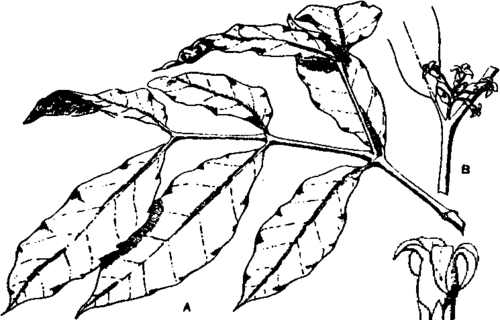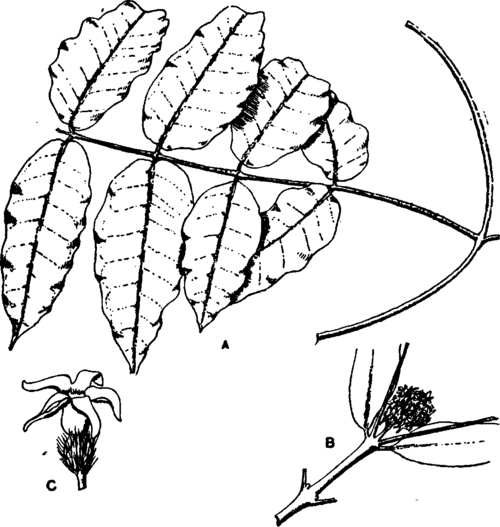African Rubbers
Description
This section is from the book "Rubber And Rubber Planting", by R. H. Lock. Also available from Amazon: Rubber And Rubber Planting.
African Rubbers
The Lagos Silk Rubber, Funtumia elastica, formerly known as Kickxia africana, is a handsome tree somewhat resembling a coffee plant when young. This rubber first came into notice in the colony of Lagos in 1894. The trees are tapped on a herring-bone system, and the latex collected in a vessel at the foot of the tree. In some districts the latex is coagulated by boiling; this method yields an inferior rubber owing to the damage often caused by excessive heating. A second method is to pour the latex into a tank excavated in the trunk of a fallen tree. The strained milk is added from day to day until the tank is full. It is then covered with palm leaves and left for 12 to 14 days or more, according to the season, until most of the watery portions have either evaporated or sunk into the wood.
The rubber obtained has a dark brown colour externally, with a paler section.
Funtumia is very susceptible to damage by intemperate tapping, and like other African rubbers, it has been largely exterminated in many districts owing to over-zealous collection. Recently plantations of this species have been established in several parts of West and Central Africa.
Although unsuitable for plantation purposes, the various climbing species of the genus Landolphia are still the chief source of wild African rubber. The

Fig. 4. Funtumia elastica. A. Branch. B. Inflorescence. C. Flower.
Landolphias are widely distributed over the whole of tropical Africa, extending from 16 degrees North latitude to 23 degrees South latitude. They are found in almost all the forest regions of this area, and include at least ten species of valuable rubber-yielding plants. Among the most important are Landolphia owariensis, which occurs throughout West Africa and the Sudan, L. Heudelotii in West Africa, and L. Kirkii and L. Dawei in East Africa. Landolphia florida, which has also an extensive range, was known as a handsome and sweet-scented flowering plant long before its commercial value was recognised.

Fig. 5. Landolphia KirM. A. Leafy twig. B. Inflorescence. C. Flower.
The rubber is exported in a great variety of forms, often as small balls or sausages. These are formed by winding up the strings of rubber which dry upon the plants, when the latter are gashed with a knife.
Ficus Vogelii is another rubber plant widely distributed in West Africa and the Sudan. There have been varying reports upon its produce, and it appears to deserve further attention.
In all the above-named species the source of the rubber is the stem. The so-called root rubbers of the Congo and Angola are derived from the Rhizomes of two semi-herbaceous plants Carpodinus lanceolatus and Clitandra henriquesiana. The creeping underground stems of these plants are about an inch in diameter. The natives extract the rubber by rasping and then boiling them in water.
In Madagascar rubber is obtained from other species of Landolphia, and from a tree, Mascarhenasia elastica, which is related to Funtumia, and resembles it in many respects.

Fig. 6. Ficus elastica.
Continue to:
- prev: Guayule Rubber
- Table of Contents
- next: Asiatic Rubbers
